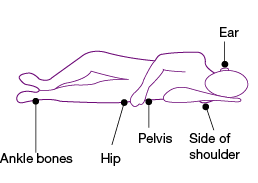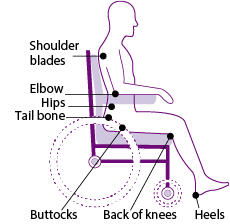Preventing pressure injuries
Spending long periods of time in a bed or chair increases your risk of developing skin breaks or blisters known as pressure injuries, or bed sores.
Pressure injuries can:- be very painful
- take a long time to heal
- increase your length of hospital stay.
 You can also read this information in an Easy Read format (external PDF 3.4KB).
You can also read this information in an Easy Read format (external PDF 3.4KB).
Risk factors
The following can increase your risk of getting a pressure injury.
- Lying in bed or chair for a long time.
- Poor control of bladder or bowels (incontinence).
- Poor circulation or diabetes.
- Having a lengthy anaesthesia.
- History of previous or existing pressure injury.
- Where medical devices such as tubes and masks come into contact with your skin.
Areas at risk of pressure injury
 |
 |
 |
| When laying on your back | When laying on your side | When seated |
How to reduce the risk
- Move frequently to redistribute pressure across your body.
- Change position in your bed or chair frequently.
- Tell your nurse if your skin looks different or you feel tingling, numbness or pain.
- Regular skin care.
- Eat a well-balanced diet.
Remember
- Move your body.
- Inspect your skin.
- Report pain to your treating team.
More information
Please speak with the treating team if you are concerned you, or a family member or friend in one of our hospitals, is at risk or is developing pressure injuries.
Last Updated:
03/07/2025

